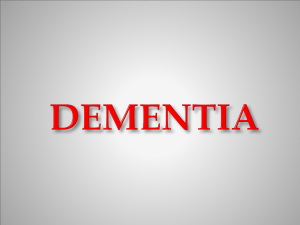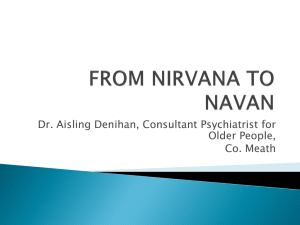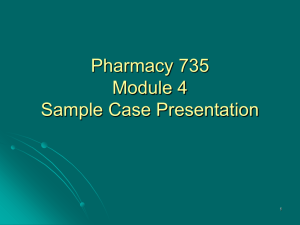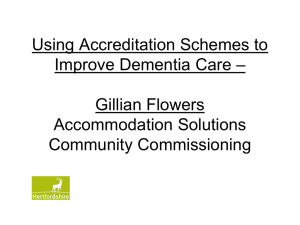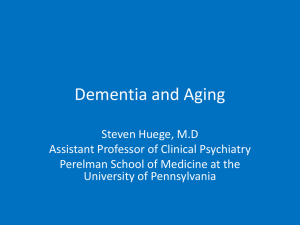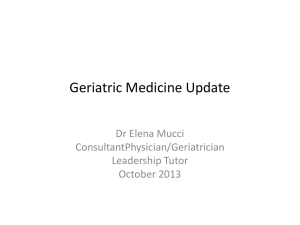Dementia - What`s New in Medicine
advertisement
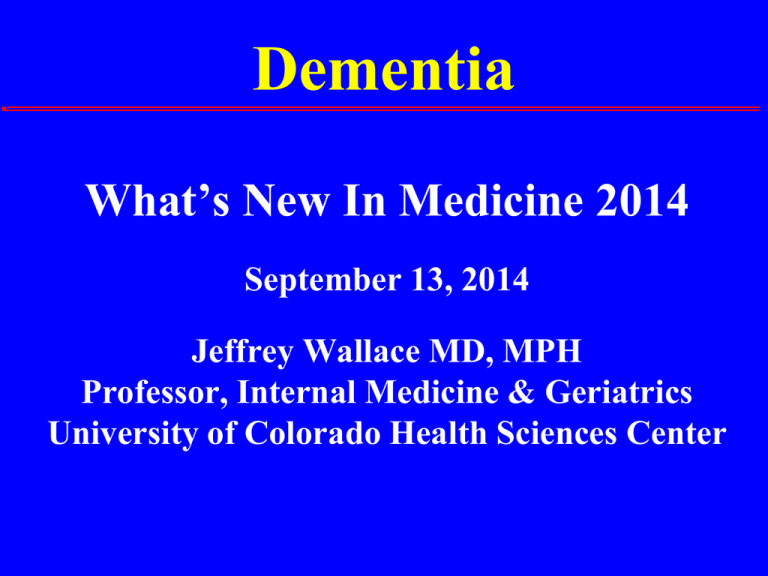
Dementia What’s New In Medicine 2014 September 13, 2014 Jeffrey Wallace MD, MPH Professor, Internal Medicine & Geriatrics University of Colorado Health Sciences Center Dementia Learning Objectives What’s new in prevention & early detection of Alzheimer’s disease Review current treatment and important considerations for helping patients (and their caregivers) with dementia Dementia: Epidemiology Prevalence Community 1% at age 60, doubles q5 years 65-74 yo 5% 80+ yo 20-40% 90+ yo Hospital 50+% 33-50% > age 70 impaired Detection Family informants 20% failed to recognize dx Primary Care group 75% screened (+) w/o chart dx Med Clin NA 2002;86:455 Screening for cognitive impairment Prevalence rates age 71+ Dementia 14% Cognitive impairment, not dementia 22% USPSTF – no clear recs pro or con d/t ? benefit dx Most pts desire (or at least accept) cog screen Affordable Care Act clinicians must assess for pts 65+ for cognitive impairment as part of annual wellness visit Ann Intern Med 2013;159:601 JAGS 2012;60:1027 & 1037 Case Hx: Possible early impairment 76yo M semi-retired accountant c/o forgetfulness Pt/spouse note ability to remember names and misplacing items over past yr. Pt more irritable. He is aware of memory Δ’s but feels getting along fine. He has continued to do accounting work during tax season & enjoys usual activities of playing cards & attending theatre. P.E. - unremarkable, non-focal neurologic, MMSE is 26/30 (error w/date, 1 of 3 STM recall, error in copy figure) Case Hx: Possible early impairment 76yo M semi-retired accountant c/o forgetfulness What is patient’s most likely dx? 1) Age associated memory impairment 2) Mild Cognitive impairment 3) Alzheimer’s disease 4) Normal aging Normal Aging Some decline in processing speed and depth of recall of new information: slower, harder Can learn new info but slower acquisition speed Non-verbal info more affected than verbal spontaneous recall Reminders work—visual tips, notes Absence of significant effects on ADLs or IADLs Mild Cognitive Impairment (MCI) Dx Criteria: 2011 NIA-Alzheimers Assoc workgroup change in cognition recognized by pt or observers objective impairment in 1 or more cognitive domains independence in functional activities preserved with minimal aid or assistance application of this criterion is the challenge Alzheimers Dement 2011;7(3):270-79 Mild Cognitive Impairment (MCI) DSM 5: “mild neurocognitive d/o” Grey zone between normal aging and dementia Most often memory problem without deficits in other domains (amnestic MCI) No functional impairment, social or occupational Predicts risk: 10-15%/yr progress to dementia dx Neurology 2001;56:1133 Ann Intern Med 2008;148:427 Mild Cognitive Impairment Which med tx has shown some benefit for pts w/MCI? 1. Cholinesterase inhibitors 2. High dose vitamin E 3. Statins 4. Ginkgo biloba 5. Fish oil Vitamin E and Donepezil for Tx of MCI NEJM 2005;352:2379-88 Vitamin E and Donepezil for Tx of MCI NEJM 2005;352:2379-88 p-values adjusted for multiple comparisons donepezil NS for all subjects at 24 mo (p=0.052) and APO 4 carriers at 36 mo (p=0.078) Mild Cognitive Impairment Non-pharmacologic interventions that may help slow transition from MCI to dementia? Physical activity - 50 minutes walking 3 days/wk JAMA 2008;300:1027-37 Mental activity - games, crosswords, leisure activities cognitive training (eg Lumosity) NEJM 2003;348:2508 Ann Intern Med 2010;153:182 Walking is good for the body --- and brain! 170 pts w/memory concerns in Australia, age 70 Tx: > 150 minutes moderate-intensity physical activity/wk (three 50-minute sessions/wk), mostly walk 6 months activity, monitor cognition for 18 months 6 mo: activity 0.26 vs 1.0 no tx (ADAS-cog) 18 mo: activity 0.73 vs 1.27 on ADAS-Cog Conclude: in adults w/subjective memory concerns, a 6month program of physical activity provided a modest improvement in cognition over an 18-month f/u period. JAMA 2008;300:1027-37 Dementia Criteria: DSM-V Definition “Dementia” out, “major neurocognitive disorder” in Requires Significant cognitive decline in 1 or more domains eg, memory, speech, judgment, visuospatial, behavior As noted by pt, family or clinician Objective evidence of “substantial” impaired cognition Sufficiently severe to interfere with usual function in everyday activities Am Psych Assoc. 2013 Diagnostic and Statistical Manual 5th Ed Cognitive Impairment Screening Rationale ● USTSPF insuff evidence for routine screen (2013) ● Yet: ● 50+% cases mild impairment missed Screening tests reasonably accurate, eg MMSE: 88% sensitivity, 86% specificity Mini-cog: 76-100% sens/ 54-85% specific Dx prompts w/u, MD/pt/family understanding Tx available (non-pharm & meds) Screen: stigma dx vs awareness, w/u, f/u, tx Ann Intern Med 2013;159:601 JAMA 2007;297:2391 Cognitive Impairment Screen Instruments Mini Mental State Exam (MMSE) Most common, most studied 7 minutes, copyrighted MMSE details/nuances Screen: 24-30 nl; 18-23 mild, 0-17 severe Education (< 27 abnl college ed, not for < 8th grade ed) Language barrier Anxiety Scoring: inexact answers, 3 item recall, world/7s Likelihood ratios (LR): (+) test 6.3, LR (-) test 0.19 JAMA 2007;297:2391 Ann Intern Med 2013;159:601 Cognitive Screen: Mini-Cog Three item recall (apple, table, penny) score: 0-3 (# items recalled) Clock Test: draw clock face, hands at 11:10 scored nl (2 points) or abnormal (0 pts) Total Score 0-5 3-5 probably not impaired 0-2 probably impaired JAGS 2003;51:1451 Cognitive Screen Instruments Simpler yet --- inquire about memory probs Patient c/o memory difficulties LR: (+) 1.8, (-) 0.36 Specificity issue: also associated w/depression Informant relates memory difficulties LR: (+) 6.5, (-) 0.1 More accurate if informant lives with pt Either way, pt/informant c/o should trigger eval (for both cognitive and mood related d/o) Neurology 2000;55:1724 JAMA 2007;297:2391 Adjunct Cognitive Tests MMSE has ceiling effect (esp higher ed pts) Montreal Cognitive Assessment (MoCA) 30 pts, 10 min www.mocatest.org sensitivity, but is this desirable??? Executive funx, visuospatial, verbal fluency clock test animal naming (4-legged animals/1 minute) words starting with letter (eg, F, then A, then S) Dementia Dx Criteria Remember screen test = screen, dementia dx Cognitive or behavioral ’s involve 2 or more of: impaired ability to acquire/recall new info impaired reasoning, judgment, decision making ↓ visuospatial abilities impaired language (speak, read, write) in personality, behavior, comportment Sufficiently severe to interfere with usual function Dementia: Epidemiology Etiology Alzheimer’s 50-70% Multi-Infarct 10-30% Lewy Body/Parkinsons 10-20% ETOH 5-10% Other < 5% Dementia: Epidemiology Which clinical feature is most suggestive of dementia with Lewy Bodies? 1) Rapid disease progression 2) Cognitive fluctuations 3) Falls 4) Good response to haldol Dementia: Lewy Body vs AD Lewy Body Dz Sxms at Presentation AD Cognitive fluctuations* % (range) 58 (8-85) % (range)__ 6 (3-11) Visual hallucinations* 33 (11-64) 13 (3-19) Auditory hallucinations 19 (13-30) 1 (0-3) Parkinsonism* 43 (10-78) 12 (5-30) Neuroleptic sensitivity 61 (0-100) 15 (0-29) Falls 28 (10-38) 9 (5-14)__ * 2 required for probable, 1 for possible LBD dx Br J Psych 2002;180:144 Dementia: Epidemiology Etiology Alzheimer’s 50-70% Multi-Infarct 10-30% Lewy Body/Parkinsons 10-20% ETOH 5-10% Other < 5% Alzheimer’s Dementia: DSM-IV Criteria Impaired memory One or more Sufficiently severe to interfere with usual function Gradual onset and continuing decline Other causes excluded - Aphasia - Apraxia - Agnosia - Executive dysfunction } prob AD Dementia: Epidemiology “Reversible” Dementia Drugs and Depression (pseudodementia) - 10-15% Other “reversible” causes < 5% Hypothyroid, B12, NPH, tumor, subdural Fully reversible cognitive impairment < 1% Clues to reversibility: duration<1yr, mild dz (MMSE>20), younger age Dementia: Treatment and Management Finding reversible dementia is uncommon Attention to 3 ‘Ds’ Coexistent Disease: 50% had unrecognized med dx Drugs - d/c all possible Depression - consider, trial of therapy 25% improved with meds/ illness tx/ depression tx Dementia: Treatment and Management Non-Pharmacologic approaches Adjust environment: clocks, calendars, lists, etc Physical activity Caregiver support Education – new HHS website www.alzheimers.gov Counseling, support groups Depression Daycenter Respite NEJM 2006;295:2148 Pharmacologic Management of Dementia Cholinesterase Inhibitors: donepezil, rivastigmine, galantamine FDA-approved for mild to severe AD Rivastigmine also approved for PD dementia All approved for vascular dementia Anticholinergics negate effects NMDA antagonists FDA-approved for mod-severe AD as monotherapy or combo therapy with AChE-I *** Trial for benefit typically takes 6mo *** Data for treatment > 1 year is lacking Efficacy of Cholinesterase Inhibitors Very modest improvement/stabilization in symptoms Cognition: ADAS-cog (range 0-70) 4 pt improvement 25-50% with tx vs 15-25% with PBO 7 pt improvement 12-20% with tx vs 2-6% with PBO Function: ADLs Decrease functional decline by 5mo compared to PBO Behavior: NPI (range 0-120) Improvements inconsistent – as low as 0 to as high as 5.6 pts Donepezil not effective for agitation NEJM 2007;357:1382 Caregiver Burden: Delay in Nursing Home Placement Some studies do suggest, but few data available powered and controlled to formally look at this AD2000 3 yr RCT – no benefit Lancet 2004; 363:2105 Effects of Cholinesterase Inhibitors on Clinical Outcomes Likely proceed but with caution: Average effect size is modest in AD; even less in vascular dementia Little data showing benefit persists beyond 12 mo Reports of funx, health care costs & NHP have flaws (eg, open label, self-selection) ADEs can be substantial GI – n/v/d, anorexia, wt loss Car - bradycardia/syncope/falls GU – urge, frequency AD2000: Lancet 2004; 363:2105-15 BMJ 2005;331:321 AGS/ABIM Choosing Wisely List of 5 Things Physicians & Patients Should Question: Part 2 Don’t prescribe AChEIs for dementia w/o periodic assessment for perceived cognitive benefits and adverse GI effects RCTs indicate modest benefits in delaying cognitive and functional decline and ↓ neuropsychiatric symptoms. Less established benefits: institutionalization, QOL, caregiver burden Discuss cognitive, functional & behavioral goals of tx prior to rx Advance care planning, education, diet & exercise and nonpharm approaches to behavioral issues are integral to care If goals of tx not attained after reasonable trial (eg, 12 wks), d/c Benefits beyond a year have not been investigated and the risks and benefits of long-term therapy have not been well-established J Am Geriatr Soc. 2014;62(5):950 Dementia: NMDA receptor antagonist Agents - memantine (approved in US 2003) Activity - blocks excitatory activity of glutamate on neurons via NMDA receptor Proposed mechanism of action - overstim of NMDA receptors implicated in neurodegenerative disorders - memantine glutamate related neurotoxicity Dementia: Memantine Monotherapy US Trial mod-severe AD (MMSE 3-14), n=252 SIB-Cog 2 0 -2 memantine placebo -4 -6 -8 -10 -12 0 4 12 28 Weeks NEJM 2003;348:1333 Dementia: Memantine Monotherapy US Trial mod-severe AD (MMSE 3-14), n=252 ADL 1 0 -1 -2 -3 -4 -5 -6 -7 memantine placebo 0 4 12 28 Weeks NEJM 2003;348:1333 Dementia: Memantine Monotherapy US Trial mod-severe AD (MMSE 3-14), n=252 CIBIC Global Score 5 4.8 memantine placebo 4.6 4.4 4.2 4 0 12 28 Weeks NEJM 2003;348:1333 Dementia Medications Your 84 yo F pt w/AD was started on donepezil 10mg in 2009 when MMSE was 23. MMSE has to 14 in 2013 but she continues to live at home, attends a daycenter 5d/wk. EBM suggests which of the following adjustments to her medications? 1. Increase donepezil to 23mg 2. Add memantine to donepezil 3. Stop donepezil and start memantine 4. Stop donepezil Dementia Medications Your 84 yo F pt w/AD was started on donepezil 10mg in 2009 when MMSE was 23. MMSE has to 14 in 2013, she continues to live at home, attends a daycenter 5d/wk. EBM suggests which of the following adjustments to her medications? 1. Increase donepezil to 23mg 2. Add memantine to donepezil (JAMA 2004) vs. 3. Stop donepezil, start memantine (NEJM 2012) 4. Stop donepezil Dementia: Donepezil + Memantine US Trial mod-severe AD (MMSE 5-14), n=404 3 Sev impair battery 2 donep+mem 1 0 donep+placeb o -1 -2 -3 0 4 8 12 Weeks 18 24 JAMA 2004;291:317 Dementia: Donepezil + Memantine US Trial mod-severe AD (MMSE 5-14), n=404 1 donep+mem ADL 0 donep+placebo -1 -2 -3 -4 0 4 8 12 18 24 Weeks JAMA 2004;291:317 Donepezil and/or Memantine for Mod-Severe Alzheimer’s Dz RCT mod-severe AD (MMSE 5-13), n=295 MMSE placebo donepezil memantine donep + mem 10 9 8 7 6 5 4 3 2 1 0 0 6 18 30 Weeks 52 NEJM 2012;366:893 Donepezil and/or Memantine for Mod-Severe Alzheimer’s Dz RCT mod-severe AD (MMSE 5-13), n=295 ADLs placebo donepezil memantine donep + mem 42 40 38 36 34 32 30 28 26 0 6 18 30 Weeks 52 NEJM 2012;366:893 When to Rx Memantine FDA approved ONLY for moderate-severe AD MMSE < 14 in RCTs showing benefit, YET In 2006, 19% of pts with mild AD in the US on rx rx’ed in 46% of pts w/mild AD in academic setting 11% pts w/MCI in national studies on memantine ~ 40% of US neurologists reported prescribing memantine at least sometimes to pts w/MCI Cost: $300+/month Arch Neurol 2011;68(8):991 Preventing or Treating SDAT Drug - Vitamin E Activity - Antioxidant/free radical scavenger Proposed mechanism of action - Protects against free-radical damage Vitamin E: 1000 units BID 1997 NEJM RCT w/(+) findings Mod-severe AD: 350 pts, age 74, x MMSE 13 Delayed endpoint of death/institutionalization/loss of ADLs/severe dementia by 145-215 days ↑ risk of falls/syncope with vit E 2005 NEJM RCT w/(-) findings 769 pts with mild cognitive impairment 212 pt developed AD over 3 yr f/u Vitamin E had no beneficial effects NEJM 1997;336:1216 NEJM 2005;352:2379 Vit E: Falling out of Favor? Mod-severe AD study had problems MCI RCT (-) New concerns? Health Study 400 IU qod, no benefits, hemorrhagic CVA JAMA 2008;300:2123 Physicians SELECT Prostate CA: 400 IU qd prostate CA JAMA 2011;306:1549 Vitamin E meta-analysis: 400+ IU/d mortality Ann Intern Med 2005;142:37 Vitamin E Safety Issues: Meta-Analysis Harm Assoc w/High Dose Vit E? 19 RCTs, 135K pts, doses 16-2000IU All cause mortality RR any dose: 1.01 (0.98-1.04) RR dose < 400IU: 0.98 (0.96-1.01) RR dose > 400IU: 1.04 (1.01-1.07,p=.03) Most studies w/older pts, chronic dz/CHD Ann Intern Med 2005;142:37 Vitamin E Safety Issues: Meta-Analysis Vit E dose IU/d (95%CI) 20 50 100 200 500 1000 2000 Adjusted for other vits/min Risk difference* Risk ratio -16 (-45 to 14) - 8 (-42 to 25) 2 (-35 to 38) 15 (-26 to 56) 38 (-11 to 87) 57 (-1 to 115) 76 (8 to 145) 0.98 (0.95-1.02) 0.99 (0.96-1.03) 1.00 (0.97-1.04) 1.01 (0.98-1.05) 1.04 (0.99-1.08) 1.06 (1.00-1.11) 1.08 (1.01-1.14) * Deaths per 10,000 persons Ann Intern Med 2005;142:37 Vitamin E and/or Memantine for Mild-Moderate AD New RCT: 600+ VA pts w/AD all ON CHOL-I Mild-mod AD: MMSE 12-26, mean 19 Vit E 1000 BID &/or memantine 10mg BID vs placebo mean 2.3 yr f/u Main outcome: in ADL funx (ADCS-ADL score) 2o outcomes: cognition, behavior, caregiver burden JAMA 2014;311:33-44 Vitamin E and/or Memantine for Mild-Moderate AD: 1o outcome Funx Vit E vs placebo - decline 19%/yr - ~6 mo , p=.03 - No harms seen Memantine vs plac - no benefit Combo vs plac - no benefit JAMA 2014;311:33-44 Vitamin E and/or Memantine for Mild-Moderate AD: 2o outcomes MMSE - NS NPI - NS All NS but all analyses favor Vit E ADAS-cog - NS CAS - NS JAMA 2014;311:33 Vitamin E and/or Memantine for Mild-Moderate AD Take Homes Memantine c/w prior studies, (-) effect w/milder dz Vit E appeared to have some benefit (but not w/memantine) MOA uncertain no risk in this trial Okay to try as long as safe --- is it??? JAMA 2014;311:33-44 Dementia Rx” “Do” take homes Non-pharm rx for everyone Daily walks & RT both beneficial Keep mind active but don’t overchallenge Try cholinesterase inhibitor (early-late dz) Probably try Vit E 2000 IU/d (mild-mod dz) Viable options when dz progresses (mod-sev dz) stay the course w/Chol-I switch to memantine add memantine & d/c Vit E? Dementia Rx” “Do Not” take homes Do not use memantine early in course of dz (MMSE 20+) When dz progresses do not increase donepezil > 10mg/d clinical gain marginal, ADE increase significant Potential concerns Does memantine mitigate Vit E benefit? Consider d/c Vit E if adding memantine Tx at some point likely w/o benefit, when to trial d/c is far from clear TALK ENDS HERE IF TIME PERMITS, FOLLOWING CONSIDERS POSSIBLE NEW TX OPTIONS ON HORIZON + POSSIBLE PREVENTION Potential options on the horizon – closest may be intranasal insulin * * 2013-14 RCTs in NEJM (-) * Alternative and Upcoming Pharmacologic Treatment Options Supplements Fish oil Ginkgo Medical Foods Axona, Souvenaid Experimental Treatments Intranasal insulin Gene therapy B-secretase inhibition B-amyloid peptide vaccine v2.0 HDAC inhibitor J-147 Saracatinib: Src kinase family inhibitor Tau therapies: TRx0237, vaccine AADvac1 Failed/Not marketed Dimebon Solanezumab and Bapineuzumab: monoclonal antibodies to bind amyloid (NEJM 2014;370:311-21,322-33) B-amyloid removal with IVIg (Lancet Neurol 2013;12:233-243) Avagacestat, Semagecestat: γ-secretase inhibition (Arch Neurol 2012;69:143040, NEJM 2013;369:341-50) Clin Ther 2013;35:1480 Any advice while waiting on advances? Dementia: Risk/Protective Factors Protective APOE2 allele Definite Intellectual activity Possible Physical activity Mediterranean diet Omega-3 fatty acids ____ Risk Factors Age Family Hx APOE4 allele Other genes† Tobacco use Head Trauma Low Education Metabolic Syn_ † Rare, early onset familial AD assoc w/mutations on chromosomes 1, 12, 14, 21 Ann Intern Med 2010;153:182 Resistance Training: Give your brain a lift 155 women age 65-75, 1 yr study Wt training 1 or 2x/wk vs balance training 2x/wk 60 minute sessions (10 warm-up & down, 40 min core) Cognitive function testing improved 11% with resistance training no change with balance/tone Arch Intern Med 2010:170;2036 Lifestyle and Dementia Bronx Aging Study: Higher level of education and cognitive leisure activities “protective” against development of AD NEJM 2003;348:2508 15 minutes aerobic exercise 3X/week reduces likelihood of dementia Ann Intern Med 2006;144:73 JAMA 2004;292:1447 “ read while on exercise bike” (preferably w/heavy book that you intermittently lift)

